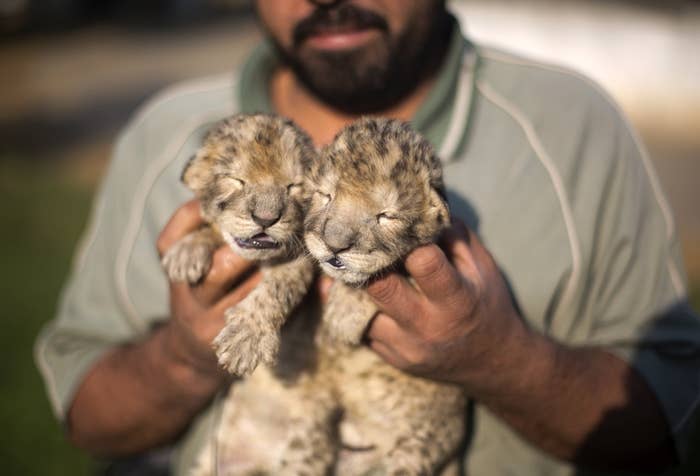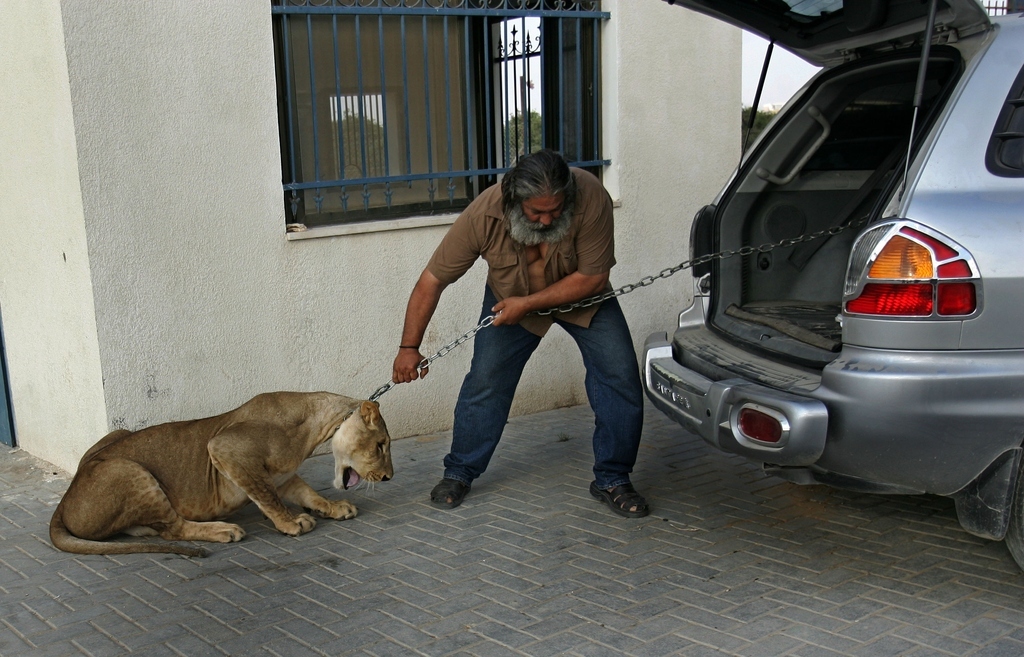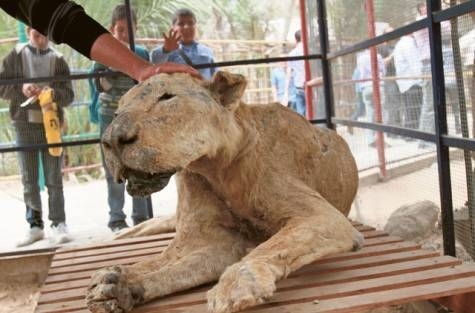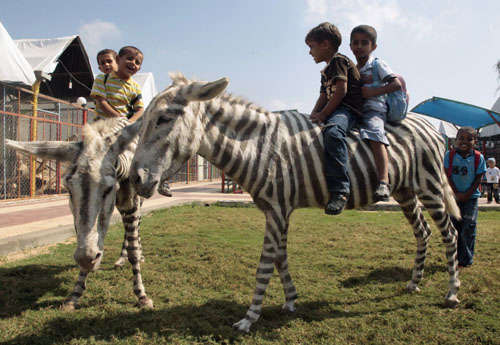
The two lion cubs born in Gaza's Bissan Zoo on Monday were barely a day old when an air strike hit the vacant lot adjacent to their new home, from where militant groups fire rockets into Israel.
It was a close call for the two cubs, zookeeper Mohammed Shabal said. But that's the life of a lion in the Gaza Strip.
"It's a huge achievement for them just to be born here in Gaza," said Shabai. "Now they must survive."
Unfortunately, by Thursday morning the lion cubs were refusing to take food and shortly after Shabai confirmed they had passed away. The zoo could not give a cause of death, but said the cubs could have been exposed to pollutants in the area.
Hundreds in Gaza had turned up at the zoo to see the cubs, but the zoo restricted access to a handful of employees, even keeping the cubs away from their parents. On Wednesday, the zoo released a video showing the two cubs and called on people to send donations of food or supplies.
"Without help, we cannot keep them here. We do not have the supplies or the resources," said Shabai.
The Bissan Zoo, which is sponsored by Hamas' interior ministry and has the backing of the Hamas movement that governs the Gaza Strip, is better off than most others. Of the five zoos currently operating in Gaza, it is the only one with the resources to keep its lions alive, let alone foster baby cubs.
The zoo named one cub Fajr, after the Iranian-made missiles fired by Hamas at Israel, and the other Sijil, the name Hamas gave last year's round of fighting with Israel.
It was perhaps inescapable that the cubs would be named after the violence that continues to rage in the Gaza Strip. The story of the lion's survival in Gaza is as unlikely as that of the constantly warring region.
Smuggled from Africa, stolen by rival Palestinian clans, shelled by Israel during war, and polluted by waters unfit for consumption, the few lions that have made it to the Gaza Strip in the past decade have had a hard life.
"We need the lions to survive, all of Palestine needs them to survive," said Abu Jameel Qassim, a manager at the small zoo in the Zeitouna neighborhood outside of Gaza City. "We almost lost the lions so many times."
He told the story of how his zoo became the first to bring two lions — brother and sister Sabrina and Suher — into Gaza 10 years ago. The two were born in Africa and smuggled across continents as cubs, then made their way to the Gaza Strip — one of the world's most densely populated areas — through a mile-long tunnel that ran under the Egyptian border with Gaza.

Other animals who made the trip with them were not so lucky. Two baby giraffes who were part of the same bundle of animals died when their sensitive necks suffered damage in the tunnels.
"We almost always bring the animals when they are babies," said Abu Muhammed, who has helped deliver dozens of exotic animals to Gaza over the last 10 years. "The lions are just like baby cats. They were easy to bring in and the monkeys."
After three more attempts to bring in giraffes failed, Abu Muhammed said his zoo stopped trying.
"Maybe there are some things that the Gaza zoos just shouldn't have," he said. "At least there are lions."
The lions have always been the pride of the three zoos spread across the north, center and southern part of the Gaza Strip.
They proved to be such an attraction that in 2006, one of the local Palestinian clans in the area stole Sabrina the lion from her enclosure.
The Dogmush family, who was also responsible for the kidnapping of BBC journalist Alan Johnson at the same time, held Sabrina for over a year. Qassim said they declawed her and removed several of her teeth before driving her around in the back of a pickup truck and charging locals $1.20 to be photographed with her.

When Hamas seized control of the Gaza Strip in July 2007 they freed Sabrina and returned her to the zoo, where Qassim said she was shell-shocked and took months to adjust to her surroundings.
It didn't help that local children's TV shows enjoyed sending actors dressed like animals to the zoo to provoke the animals, in what Qassim called a misguided attempt to highlight the problem with animal abuse.
Sabrina, however, recovered and by late 2008 she was pregnant with her mate Saher. Things were looking better for the pride until war broke out between Israel and Gaza on Dec. 27, 2008.
During the three-week operation, more than 1,400 Palestinians and 13 Israelis were killed. White phosphorous, a dangerous incendiary weapon rained down on Gaza, including on the zoos.
Most of the animals died — some of starvation and others from stray bullets or shrapnel. Sabrina and Saher escaped their cages. Qassim think they survived by eating some of the other animals before seeking refuge in the zoo's public bathrooms.
Qassim said he was "shocked" when he found them, starving and afraid. Less than week later, Sabrina lost her litter.
Across Gaza, other zoos were suffering similar problems.
In Khan Younis, the South Forest Park Zoo once boasted lions, camels, zebras, and monkeys. But over the years, all the animals died — some from exposure to pollutants during Israeli strikes on the Gaza Strip, and from starvation and disease.
Rather than shut down, the owners decided to try their best at taxidermy.

Today, a mangy cat sits a few cages away from a monkey missing an eye and several limbs. The porcupine has a large hole on the top of its skull due to a mistake made while the park's owner, Mohamed Awaida, was trying to preserve him with an improvised formula of sawdust and formaldehyde.
In Gaza's Marah Land Zoo, owner Amad Barghouti found that it was too expensive to replace his only two zebras, both of whom died during an Israeli operation in Gaza. So instead, he decided to paint a pair of donkey's using some black hair dye and some tape.
"We do what we can," he said. "The children love them."


